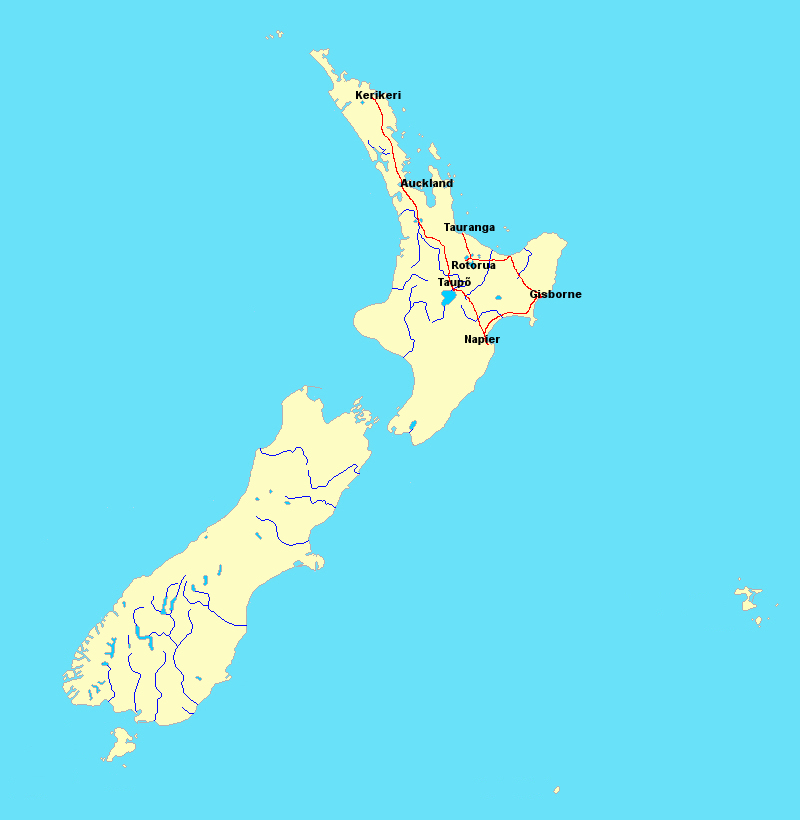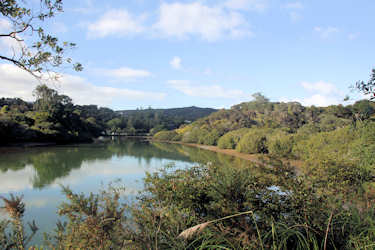New Zealand

Historie
New Zealand was one of the last major landmasses settled by humans; it was first settled by Eastern Polynesians between
1250 and 1300, concluding a long series of voyages through the southern Pacific islands.
Over several centuries in isolation, the Polynesian settlers developed a unique culture that became known as the "Maori", with their
own language, a rich mythology, distinctive crafts and performing arts. Early Maori formed tribal groups, based on eastern Polynesian social
customs and organisation. Horticulture flourished using plants they introduced, and later a prominent warrior culture emerged.
The first Europeans known to have reached New Zealand were Dutch explorer Abel Tasman and his crew in 1642. In a hostile encounter,
four crew members were killed and at least one Maori was hit by canister shot.
Europeans did not revisit New Zealand until 1769 when British explorer James Cook mapped almost the entire coastline.
Following Cook, New Zealand was visited by numerous European and North American whaling, sealing and trading ships. They traded food, metal
tools, weapons and other goods for timber, food, artifacts and water.
The introduction of the potato and the musket transformed Maori agriculture and warfare. Potatoes provided a reliable food surplus, which
enabled longer and more sustained military campaigns. The resulting intertribal Musket Wars encompassed over 600 battles between
1801 and 1840, killing 30.000–40.000 Maori.
From the early 19th century, Christian missionaries began to settle New Zealand, eventually converting most of the Maori population. The
Maori population declined to around 40 percent of its pre-contact level during the 19th century; introduced diseases were the major factor.
In 1788 Captain Arthur Phillip assumed the position of Governor of the new British colony of New South Wales which according to
his commission included New Zealand.
The Treaty of Waitangi is a treaty first signed on 6 February 1840 by representatives of the British Crown and various Maori chiefs
from the North Island of New Zealand. The Treaty established a British Governor of New Zealand, recognised Maori ownership of their lands
and other properties, and gave the Maori the rights of British subjects.
In 1891 the Liberal Party led by John Ballance came to power as the first organised political party. The Liberal Government, later
led by Richard Seddon, passed many important social and economic measures. In 1893 New Zealand was the first nation in the world to
grant all women the right to vote and in 1894 pioneered the adoption of compulsory arbitration between employers and unions. In 1898 Seddon's
government passed the Old-age Pensions Act of 1898, the first general pensions scheme in the British Empire.
In 1907, at the request of the New Zealand Parliament, King Edward VII proclaimed New Zealand a Dominion within the British Empire,
reflecting its self-governing status. In 1947 the country adopted the Statute of Westminster, confirming that the British parliament
could no longer legislate for New Zealand without the consent of New Zealand.
New Zealand was involved in world affairs, fighting, as part of the British Empire, in the First and Second World Wars and suffering through
the Great Depression.
The country's economy suffered in the aftermath of the 1973 global energy crisis, the loss of New Zealand's biggest export market upon Britain's
entry to the European Economic Community, and rampant inflation
The economic reforms were led by finance minister Roger Douglas (finance minister 1984–1988), who enacted fundamental, radically
neo-liberal and unexpectedly pro-free market reforms known as Rogernomics. This involved removing many of the favours and barriers that had
long insulated the economy from world trends. It involved floating the New Zealand dollar, cutting government spending, reducing most
taxes and introducing a sales tax (GST), and removing most subsidies.
Voters unhappy with the rapid speed and far-reaching extent of reforms elected a National government in 1990, led by Jim Bolger. However
the new government continued the economic reforms of the previous Labour government, in what was known as Ruthanasia. Unhappy with
what seemed to be a pattern of governments failing to reflect the mood of the electorate, New Zealanders in 1992 and 1993 voted to change
the electoral system to mixed-member proportional (MMP), a form of proportional representation. New Zealand's first MMP election was
held in 1996. Following the election National was returned to power in coalition with the New Zealand First Party.
The Fifth Labour Government led by Helen Clark was formed following the December 1999 election. In power for nine years, it
maintained most of the previous governments' economic reforms – restricting government intervention in the economy much more so than
previous governments – while putting more of an emphasis on social policy and outcomes.
John Key led the National Party to victory in the November 2008.
A Labour-led coalition Government led by Prime Minister Jacinda Ardern was formed in October 2017. Among other issues, it plans to
tackle a burgeoning housing shortage crisis in New Zealand.
I have visited New Zealand in april 2015.
It was part of the West Pacific Odessey
On that trip i have seen
Auckland
Kerikeri
Taupõ
Napier
Gisborne
Rotorua
Tauranga
Please let me know when you're having questions.
i would be pleased to help you.
Things to do and other tips
